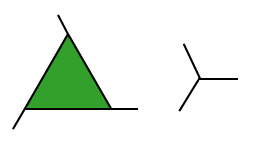|
POLYGONS
Our first topic is polygons. You will have some idea about what a polygon is.
|
|
|
|
|
The delight of mathematics is that we can define our terms how we like. But it is helpful if everyone used the same definitions. Here we would probably want to exclude figure (a) because it is not closed (doesn’t link up), and the figure (c) because of the curved arc. We will allow the other three. Definition: A polygon is a finite set of (straight) line segments A1A2, A2A3, ... , An–1An, AnA1 (n Figure (e) is an example of a convex polygon – it has no re-entrant angles. Figures (b) and (d) are non-convex polygons. Figure (b) is described as a self-intersecting polygon. |
|
|
|
|
A polygon is said to be equilateral if all its sides have the same length. So Figure (a), the equilateral triangle, is equilateral, equiangular, and regular. It is the only polygon for which either of the equilateral and equiangular conditions implies the other. The square (b) is also equilateral, equiangular and regular, as is the pentagram (e). The vertices of the pentagram are the five outer points. The rectangle (c) is equiangular, but not equilateral or regular. the rhombus (d) is equilateral, but not equiangular or regular. A convex regular polygon with n sides is often denoted by {n}. In these pages we shall be mostly concerned with regular polygons. |
|
|
|
|
|
We obtain the sequence in radians, 2
Clearly the interior angle of a regular n-gon measures |


 Any convex regular polygon has obvious (equal) interior angles. If we move around the polygon in an anti-clockwise direction, extending each edge a short distance, we obtain a set of equal exterior angles. It is easiest to calculate the exterior angles.
Any convex regular polygon has obvious (equal) interior angles. If we move around the polygon in an anti-clockwise direction, extending each edge a short distance, we obtain a set of equal exterior angles. It is easiest to calculate the exterior angles.